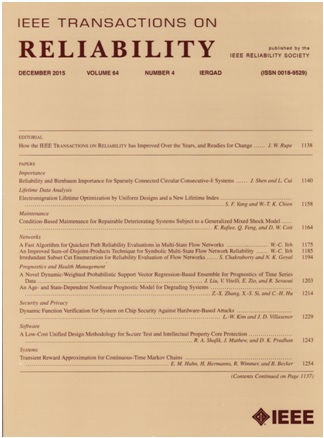复杂机械系统故障隔离的物理统计框架
IF 5.7
2区 计算机科学
Q1 COMPUTER SCIENCE, HARDWARE & ARCHITECTURE
引用次数: 0
摘要
高速列车动力转向架、非动力转向架、风力发电机组等复杂机械系统的监控与数据采集(SCADA)数据被广泛用于异常检测和故障隔离。SCADA数据包括系统中关键组件的过程变量和外生协变量的测量。过程变量是指关键部件的性能特征,外生协变量是指复杂机械系统的工作载荷或工作条件。在系统动态运动规律等物理机制的主导下,过程变量和协变量之间存在复杂的关系,给异常检测和故障隔离带来了困难。为了解决这个问题,我们提出了一个整合物理知识和统计学习的框架。我们首先建立一个样条模型来捕捉过程变量和外生协变量之间的关系。为了使模型可解释,我们使用物理知识对模型参数施加约束。然后,我们根据物理统计回归模型在系统级进行异常检测。一旦检测到异常,我们提出了一种基于lasso的方法来隔离故障组件。我们的故障隔离方法不需要历史故障数据,也不需要知道故障部件的真实数量。对高速列车动力转向架的实际案例研究表明了我们的框架的优势:与我们的方法相比,最佳基准在异常检测方面至少降低了2.50%的f1分数,在故障隔离方面至少降低了6.01%的f1分数。本文章由计算机程序翻译,如有差异,请以英文原文为准。
A Physical-Statistical Framework on Complex Mechanical System Fault Isolation
Supervisory control and data acquisition (SCADA) data from a complex mechanical system, such as a high-speed train power bogie, nonpower bogie, and wind turbine, are widely used for anomaly detection and fault isolation. The SCADA data include measurements of process variables and exogenous covariates for key components in the system. The process variables refer to the performance characteristics of the key component while the exogenous covariates are working loads or working conditions of the complex mechanical system. Dominated by such physical mechanisms as dynamic motion laws of the system, there are complex relationships between the process variables and covariates, that complicate anomaly detection and fault isolation. To solve this problem, we propose a framework that integrates physical knowledge and statistical learning. We first build a spline model to capture the relationship between process variables and exogenous covariates. To make the model interpretable, we use physical knowledge to impose constraints on the model parameters. We then conduct anomaly detection at a system level based on the physical-statistical regression model. Once an anomaly is detected, we propose a Lasso-based method to isolate the faulty components. Our fault isolation method does not require historical failure data or knowing the true number of faulty components. Real-world case studies on power bogies from high-speed trains illustrate the advantages of our framework: the best benchmark achieves at least 2.50% lower F1-score in anomaly detection and 6.01% lower F1-score in fault isolation compared to our method.
求助全文
通过发布文献求助,成功后即可免费获取论文全文。
去求助
来源期刊

IEEE Transactions on Reliability
工程技术-工程:电子与电气
CiteScore
12.20
自引率
8.50%
发文量
153
审稿时长
7.5 months
期刊介绍:
IEEE Transactions on Reliability is a refereed journal for the reliability and allied disciplines including, but not limited to, maintainability, physics of failure, life testing, prognostics, design and manufacture for reliability, reliability for systems of systems, network availability, mission success, warranty, safety, and various measures of effectiveness. Topics eligible for publication range from hardware to software, from materials to systems, from consumer and industrial devices to manufacturing plants, from individual items to networks, from techniques for making things better to ways of predicting and measuring behavior in the field. As an engineering subject that supports new and existing technologies, we constantly expand into new areas of the assurance sciences.
 求助内容:
求助内容: 应助结果提醒方式:
应助结果提醒方式:


